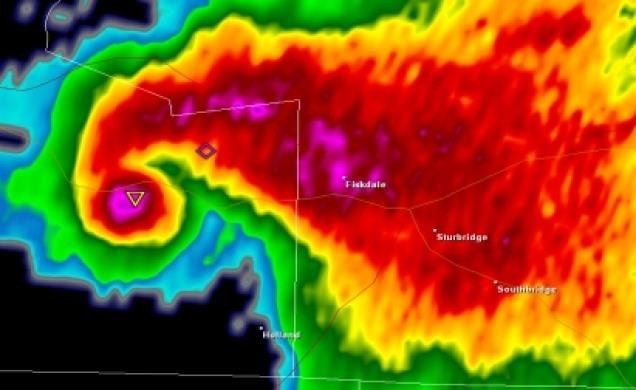-
Posts
78,703 -
Joined
-
Last visited
Content Type
Profiles
Blogs
Forums
American Weather
Media Demo
Store
Gallery
Everything posted by weatherwiz
-
Safe sex is like safe weather...except you can't pull out of weather
-
Yes, but I guess it comes with the territory. I'm serious though...if the timing can work out next Thursday that's a very solid setup. 80-90+ knot mlvl jet streak moving in with potential for 60+ surface dewpoints. Way too early for other details but a combo of those two is an eye catcher
-
Yeah looks like it gets squashed just southwest of us. While EWR is probably taking on a few more 90's while BDL may have a tough time getting much past 80 outside of Sunday.
-
Severe weather threat next Monday and Thursday!!! Next Thursday if we could timing to work out could maybe be best setup of the season
-
Decided to work outside yesterday and doing so today. Despite being 10+ colder this morning it actually feels way better than yesterday given no wind. It's actually rather pleasant and refreshing.
-
Has anyone come across the YouTube channel, "Ryan Hall, Y'all".
-
That's exactly what it looked like! I tried to get a close up but every time I zoomed in the camera wouldn't focus. I suppose I could have gone closer to the spider but I was afraid it would have jumped on me. My girlfriend killed it though. I sprayed it from afar and when it fell I ran and she got it.
-
Ughhh there is a giant spider. Hope it’s not a wolf spider
-
Certainly does. And it paves the path for additional exploring and factoring in teleconnections (PDO, PNA, Arctic, QBO, etc).
-
Woah...that is amazing stuff! It's explained so beautifully and simply too.
-
Are the Pats home that Sunday? Maybe the wind can help propel the Pats into the end zone
-
Something that always didn't sit well with me when doing a singular composite is the uncertainty of whether the composite is being influenced by seasons which were more on the anomalous side. Now there is nothing you can really do about this, though I'm sure someone with an impeccable background in mathematics and programming could develop something. For example, I've been working on this tornado project (which I started like 12-years ago) which I used for senior thesis, and then finally made some significant progress with during this past spring. But when calculating averages I was always worried about an average being skewed due to outliers. So let's say I wanted to calculate the spring tornado average for the whole U.S. Naturally you would just add up the number of spring tornadoes from 1950-present and divide by the number of years. But what I did was find outliers using statistics and removed any outlier years in the calculating of the average. You have some Nina's that were quite cold and other's which were quite warm and at the end of the day how do these extremes influence the composite? It's with this that I think composites can be a bit misleading but that doesn't go to say there is value in them but I think the best value overall is when you're doing a composite of something that is extremely similar with little deviation (for example, creating a composite of the top 10 -NAO December's).
-
Ahh gotcha, I see what you mean. You're asking what period would I choose if I were to throw all Nina winters to get an averaged temperature output. This is a great question, I think in this case I would choose exactly what you did and go with 1951-2010 period. But since I'm also doing events prior to 1950 I would consider something like 1895-2000.
-
It will be great to compare results and see if there is much of a difference say comparing 1976 to a 1941-1970 climo vs. 1951-2010 climo.
-
For temperatures (at least) I'm using these climate periods. The year range in parenthesis will be the years to compare to that climo period. 1871-1900 (1901-1910) 1881-1910 (1911-1920) 1891-1920 (1921-1930) 1901-1930 (1931-1940) 1911-1940 (1941-1950) 1921-1950 (1951-1960) 1931-1960 (1961-1970) 1941-1960 (1971-1980) 1951-1980 (1981-1990) 1961-1990 (1991-2000) 1971-2000 (2001-2010) 1981-2010 (2011-2020) 1991-2020 (2021-2030) Since NCEP/NCAR reanalysis I only dates back to 1948 for years from 1904-1980 I ran against the 20th Century Reanalysis V3 and years from 1981-present I ran against the NCEP/NCAR reanalysis. The reason I started from 1981 for NCEP/NCAR reanalysis is given the dataset does not begin until 1948 the starting climo period would be 1951-1980. What I do want to check though is to make sure there are no big discrepancies. When I originally started I just did 20th century Reanalysis (which goes through 2015) but I noticed that yielded much different results for 2010-2011 then the NCEP/NCAR reanalysis did. I am unsure if I want to use this breakdown for precipitation, outgoing longwave radiation, wind anomalies, etc but I am thinking of doing so and compare periods...this way we could gauge whether or not we're seeing different response over time due to warming.
-
Yup...it seems to happen after like a few minutes. It will look like this (just happened to me too)
-
What sucks too is (and I don't know why this is) but after a certain amount of time, when you hit the back button going from the plot to the selection screen, it will remove the dataset 2 (even though the box is checked). So you have to uncheck the box and re-check. Not sure if this is a bug or glitch but it's annoying
-
That's how it goes I have to say the worst for me in that regard was August 27, 2020 when we had that textbook supercell truck southeast across Connecticut. I left work early in Branford to chase and went to Waterbury (I still saw a sick storm and it was wild)...but Branford hot clobbered and there was damage all over.
-
It's working for me. Make sure in the variable statistic you have mean selected and not anomaly and your dataset 1 and dataset 2 options are the same.
-
But we sucked even more than usual It's like being an NFL team and usually winning 6-7 games a season then coming in with a 3 win season
-
It was a terrible summer. At least the Pats have started and the Bruins start pre-season games in like 10-games and regular season in about a month. Celtics should be exciting again but I can't stomach to watch the NBA anymore...I just get the updates on my phone.
-
hmmm I should get some time to do some more stuff with this in a bit and I'll see if I have the same issues. I'm hoping to re-upload all the GIFs with the corrections today too.
-
Definitely is intriguing. Looks in the vicinity of where the velocity couplet was.
-
Do you have CC with that? Looking from BOX for any brief TDS
-
Wow yeah that’s solid






